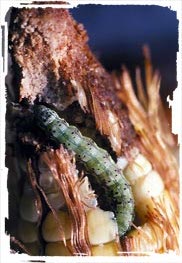CIMMYT E-News, vol 2 no. 8, August 2005
 Farmers seal the corn earworm’s fate in Peru with an oily approach.
Farmers seal the corn earworm’s fate in Peru with an oily approach.
Far from markets or access to agricultural inputs, maize farmers high in the Andes of northern Peru are applying what’s at hand—including common cooking oil—to control corn earworm, a pest that used to halve their harvests. Their approach is based on experiments in the 1980s by researchers like Toribio Tejada Campos, an agronomist at Peru’s National Institute of Agrarian Research and Extension (INIA). But farmers have taken the method further, adding plastic soda bottles and bamboo “straws.”
“Everyone around here uses oil on their maize ears,” says farmer Milciades Ramírez Sánchez, of Cajamarca Department, who with his family survives growing maize, potato, and other diverse crops on less than a hectare of land. Some farmers apply the oil with small rags, sponges, or eyedroppers, but Ramírez and his wife, Jesús Quispe Correa, invented an improved applicator by perforating the cap of a plastic soda bottle and inserting a hollow bamboo twig. “We had the idea about a year ago,” says Ramírez. “Before the use of oil, we would feed infested ears to the animals. If we don’t apply it, as much as half the maize gets earworms.”
Corn earworm larvae are small but carry a large scientific name—Helicoverpa (=Heliothis) zea—and an even larger appetite. They normally start feeding on the silks, thereby impairing kernel fertilization and development. The growing larvae eventually proceed down into the ear and bore into kernels near the tip and as far as mid-ear. Besides the kernel damage it causes, their feeding opens passages for the entry of fungal

Cajamarca has roughly 1.5 million inhabitants, of which more than 70% live in isolated, rural areas, and nearly half are considered poor by Peruvian standards. Large families with inadequate housing, water, services, health care, or educational opportunities typify the region, and most farm homesteads average two hectares. “Milciades and Jesús are among the lucky few that have access to irrigation,” says Alicia Elizabeth Medina Hoyos, a colleague of Tejada’s at INIA’s Baños del Inca Experiment Station. “Milciades has little land, but likes to experiment.”
Tejada, who recalls with pleasure an in-service training course he attended at CIMMYT in 1987-8, says that farmers are hungry for new ideas, support, and techniques: “There’s also great interest in better market access and an awareness of the need to conserve natural resources,” he explains, “but it’s a process that’s just beginning. CIMMYT has played a catalytic role that’s hard to measure, but real.”
In addition to offering training, visiting scientist appointments, and thesis advisory services for Peruvian researchers, CIMMYT has contributed extensively to improved Peruvian varieties of wheat, barley, and—especially—maize (see A Maize for Farmers on the Edge: CIMMYT-Peru maize, Marginal 28, outstrips expectations for farmers in Peru).
For further information, contact Luis Narro (l.narro@cgiar.org).
 Climate adaptation and mitigation
Climate adaptation and mitigation 
